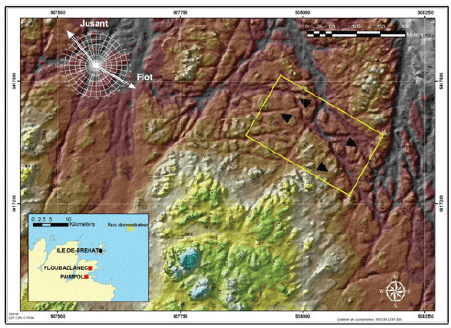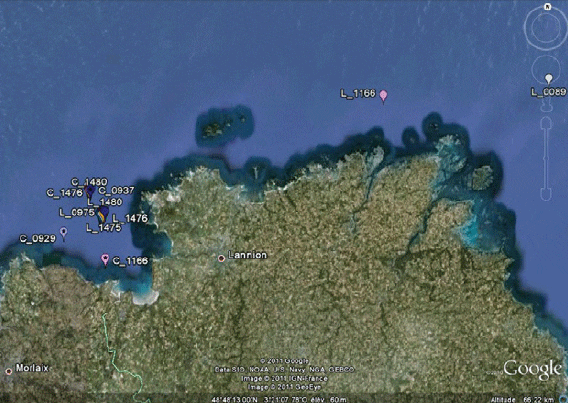Framework: a project of marine turbines installed within a fishing reserve
A project of experimental marine turbines,
conducted by EDF (Electricit de France),
was initiated in 2005.
Very early in their project, EDF contacted
the professional fishermen throughout the
Local Fisheries Committee of Lannion-
Paimpol (CLPM). Indeed, the waters coming
under the legal competence of the CLPM
were potentially useful for the exploitation of
tidal currents and EDF wanted to involve all
the stakeholders in this venture, especially
fishermen. In order to have the minimum impact
on fishing activity, the CLPM proposed
to install the experimental devices within a
fishery reserve area called La Horaine. This
area was created in 1966 by the professional
fishermen who wanted to protect crustaceans
(lobsters, spiny lobsters, brown crab
and spider crab); the exploitation of which is
historically and economically very important.
Thus, since 1966, all gear is prohibited in the
reserve of La Horaine, excepted lines and long-lines. Technical studies showed that the
request was feasible.
After a study trip in Ireland with EDF
and a delegation of professional fishermen
in 2007, discussions began between the
company and the CLPM in order to decide
what kind of partnership they wanted to established.
Both of them agreed that funding a
collective program on the resources exploited by the majority of the fishermen was better
than giving individual financial compensation.
In June 2008, members of the CLPMs
council voted by a majority in favour of EDF
placing four experimental marine turbines in
the Paimpol-Brhat area, placed within the
reserve of La Horaine.
Then in 2009, the CLPM started to study
the stock and the local European lobster fishery across the entire maritime district of
Paimpol. The operational part of this study is
funded by EDF; the working time is supported
by the Dpartement des Ctes dArmor,
the Rgion Bretagne and the European
Fisheries Fund. The first experimental marine
turbine was expected for autumn 2011, to be
followed by three other turbines in 2012

A study led by the professional fishermen
The first stage of this study took place during
the 2009 lobsters fishery, and involved 19
professional fishing boats. It consisted in
notching a V mark in the tail of the female
lobster, bought from a professional fisherman,
and to release V-notched lobsters to
the sea. As a professional or leisure fisherman
caught a V-notched female lobster,
he had to report it to the CLPM with the
position of the catch. Of 1, 989 lobsters
V-notched and released at sea, about thirty
have been recovered. Such a small return did
not provide a lot of information, but it helped
greatly to advertise the program to the professional
and the leisure fishermen.
From that first campaign, the CLPM repeated
the notching campaign in 2010, with
1, 885 lobsters from 21 professional fishing boats. But in order to get individual information about displacements and growth,
a yellow numbered tag was applied in the
abdomen of each lobster, after the lobster
had been weighed and measured. Lobsters
were then released at sea by the CLPM, in 3
different areas, one of which was within the
reserve of La Horaine. At the same time, a
series of boardings of two professional fishing
boats permitted sampling of all lobsters
caught in pots, even lobsters under commercial
size, through all season of lobster fishing.
Sex, carapace length, number of pots used,
area of fishing were noted to calculate indicators
of exploitation.
In 2011, the same method of V-notched
and numbered tag was applied on 1, 459
males and females lobsters from 13 professional
fishing boats. The same kind of sample
on board of the same two professional
fishing boats was made. Furthermore, the
CLPM put in place fishing within the reserve
of La Horaine, with the intention of getting
a long-term series of data to be compared
with indicators of exploitation calculated out
of the reserve. In that aim, three lines of pots
were put in the reserve by the professional
boats with the CLPM sampling the catches.
Then all the pots, those put out of and those
put in the reserve, could be sampled on
the same day and a comparison could be
made. Moreover, one line of pots put in the
reserve of La Horaine was placed where the 4 experimental marine turbines were to be
installed.

Lobster movements
From the campaigns in 2010 and 2011, 73
tagged lobsters were recovered, 14 by leisure
fishermen. Of those 73 lobsters, 34 are
considered to show significant movements,
while 35 didnt move from the point of
release. The other four tagged lobsters had
been bought by restaurants, fishmongers or
by customers on markets, and their catch
position was not known.
Almost all the lobsters that moved travelled
in a westerly direction from the point of
release. Some of these lobsters travelled very
long distance in a relatively short time. For
example, one lobster was caught 55 nautical
miles from its point of release only 2 months
later.
A few favoured recovery spots were
noticed, such as the coasts of Ile de Batz,
where 7 lobsters tagged in 2010 and 1
tagged in 2011, from different areas of
release, have been found.
On the contrary, lobsters released in the
Bay of Lannion, located at the West of the
maritime district of Paimpol, seem to stay
within the Bay. The circular marine currents
and the closeness of a rocky seabed may keep them in that Bay. Further research on
the causes of displacement is considered
necessary.

An efficient fishing reserve
Sampling on board the professional fishing boats revealed a larger range of sizes within the reserve of La Horaine, compare to outside. In the same way, the mean carapace length seems to be bigger within the reserve, as is the mean weight. Moreover, the catch rate of commercial lobsters (i.e. where the carapace length is above the minimum landing size of 87mm) is higher in lines put in the reserve than in lines put outside. Thus, the catch per unit of effort (CPUE in Kg of lobster per 100 pots) is higher within the reserve compared to outside, whatever the season. To make a complete assessment of the reserve effect and to assure a correct survey of the stock of lobsters exploitation, the sampling has to be continued in the future in a similar way.
Above all the scientific results, this program make different sea users acting together
As said before, this program is partly funded by EDF, realized by a professional organization with the participation and for the interest of the local professional fishermen and supported by leisure fishermen. Actually, the associations of leisure fishery of the maritime district of Lannion-Paimpol are fully implicated in this program: fourteen of them reported re-catches of tagged lobsters in 2010 and 2011, and two of the lobsters that have been tagged were from leisure fishery. Being on board or in the harbours to tag the lobsters allows discussions with everyone working around the fishery industry, even with the general public. Information about the EDFs project or about the lobster fishery can be provided and a certain conception of the fishermen and their implication in improving knowledge about the stocks they are exploiting can arise from that kind of program.
July 2012


